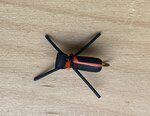Recent rains have kept rivers and streams at a favorable above-average level over the past week, and despite warm temperatures in the high 70s and 80s with lots of humidity, the added volume has kept …
This item is available in full to subscribers.
Please log in to continue |


Recent rains have kept rivers and streams at a favorable above-average level over the past week, and despite warm temperatures in the high 70s and 80s with lots of humidity, the added volume has kept water temperatures at a fairly decent level registering in the high 60s for much of the week.
The Beaverkill at Cooks Falls crested at 2,630 cubic feet per second at 11:00 am on Sunday morning, which is well above the median average flow on this date of 161 cfs over 109 years of record-keeping.
Thunderstorms have kept most trout fishers out of the river, but in-between showers and storms some hardy anglers were able to get out and catch a few fish. Flies that were hatching during the past week include caddis flies in a variety of sizes and colors, smaller Blue-Winged Olives and Sulphurs as well as Isonychias.
However, when flows are high, roily and discolored, as they were on Sunday morning, your best bet is to fish below the surface with nymphs, wet flies and streamers. Larger, dark colored nymphs will show up somewhat in discolored water, and you can use a wet fly as an attractor fly, fishing the duo by lobbing the flies across the stream from where you’re standing and following the leader downstream, then slowly retrieving while ‘twitching’ the flies to provide movement. Be ready to strike when you notice your leader hesitate or stop moving.
It’s a good idea to carry along some terrestrial flies, especially with the rain showers and storms we’ve been experiencing. During the heat of summer, trout will often move toward the shoreline, seeking shade and shelter, especially in areas with undercut banks, overhanging or downed trees or logs.
After a rainstorm or windy weather, they will benefit from feasting on ants, beetles, inchworms, grasshoppers and other terrestrials that will drop or be washed into the water below. Trout fishers will often find success casting their terrestrial flies along the shoreline, and especially near overhanging trees or logs.
John, a friend who was up from Pennsylvania this past weekend for the Livingston Manor Town Tag Sale, had the opportunity to make just a few casts on the Willowemoc from the shore on Saturday and, despite the high water, was delighted to catch a nice brown trout on a cricket imitation he’d tied.
The Catskill Fly Tyers Guild had their in-person tying meeting last Saturday at the Wulff Gallery of the Catskill Fly Fishing Center. Members were tying their favorite terrestrial flies, and worked on patterns such as this Lightning Bug, tied by John Apgar, the CFT Guild’s Vice President.
John reported that he’s been doing really well with this fly during the summer months here in the Catskills, and added that it’s possible that the trout are, “just taking it for a long beetle,” but that he ties the fly to mimic a lightning bug or firefly.
Here is the pattern that John uses to tie his Lightning Bug:
Hook: TMC 100 (or a standard dry-fly hook) in size 12
Thread: Black 8/0
Stripe on back: Florescent orange Uni Stretch (also used for hot spot near head)
Shellback and head: Razor Foam in 1mm thickness
Glowing spot: Yellow Superfine dubbing tied in at the rear of the body
Body: Black Superfine dubbing
Legs: Small round rubber legs
Comments
No comments on this item Please log in to comment by clicking here